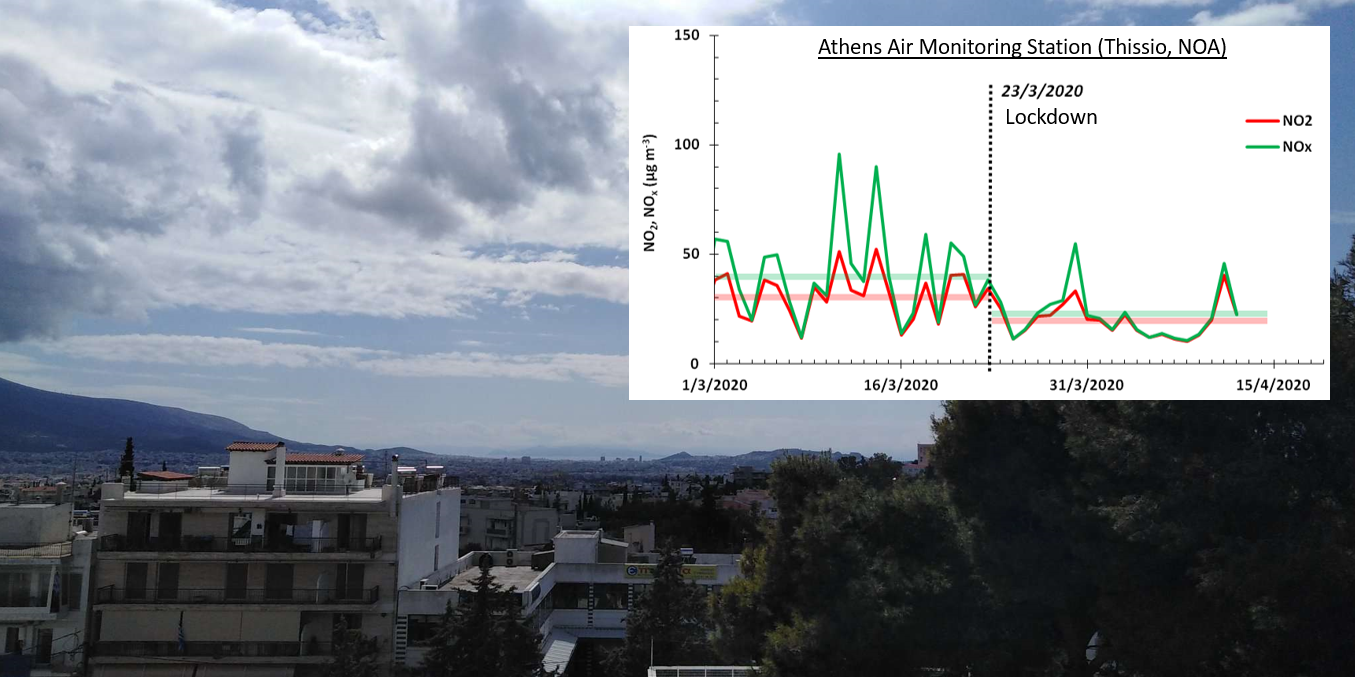COVID-19: 3 weeks of "stay at home" and the effects on the levels of air pollution in Athens (APCG press release, 14 April, 2020)
In the context of the continuous monitoring of air pollution in Athens over the last decade, the Atmospheric Physics and Chemistry Group (http://apcg.meteo.noa.gr/) of the Institute for Environmental Research and Sustainable Development (IERSD) of the National Observatory of Athens (NOA), conducts specialized measurements at NOA’s Atmospheric Pollution Monitoring Station, at the central premises of NOA in Thissio, Athens. In order to assess the changes in pollution in the recent weeks, due to the restrictive traffic measures taken to prevent the spread of COVID-19, basic and specialized pollutants that characterize different types of human activity have been used. Their evolution, both in relation to the period before the “lockdown” and in comparison with the previous years, was examined, taking also into account the changes in the meteorological conditions.
The main measurements concern nitrogen oxides (NOx: NO + ΝΟ2), black carbon (BC), carbon monoxide (CO) and particulate matter with a diameter of less than 2.5 micrometers (PM2.5), while for the first time the concentration of carbon dioxide (CO2) in an urban environment in Greece is monitored with continuous measurements, as well as the concentrations of basic minerals and other PM2.5 fine particle components (e.g. Cu-copper, Pb-lead, Zn-zinc, S-sulfur). All measurements are performed with modern time analysis techniques with high resolution from minutes to a few hours, enabling the detection of differences in chemical composition during the day. Part of these measurements are accessible through the BEYOND Center of Excellence platform (http://webgiscovid19.beyond-eocenter.eu/pollutants.php).

March 23, 2020 (when the traffic ban began in Greece) has been designated as a milestone for the comparison of pollution levels and the current analysis includes measurements date up to April 12, 2020. The period from March 1 to March 22, 2020, was used as the reference period before the measures. It is noted that the relatively increased rainfall during the second period had no effect on the estimated rates of change in gases and small effect on particulate pollutants.
The main conclusions are summarized as follows:
- In general, there has been a decrease in the concentrations of gaseous pollutants associated with combustion processes. In particular, nitrogen oxides (NOx), mainly from car emissions, were reduced by 45%, with nitrogen dioxide (ΝΟ2) levels, which is considered a legislated pollutant, reduced by 35%. Carbon monoxide (CO), produced from incomplete combustion of fossil fuels and biomass, also declined by 30%.
- Carbon dioxide (CO2) greenhouse gas levels, a characteristic component of man-made pollution emissions globally, fell by 2%. However, with regard to the urban contribution, taking into account the regional background, a significant reduction of 35% was observed.
- The concentrations of PM2.5 showed a decrease of 20%. In particular, particles locally emitted mainly from circulation, such as black carbon (BC) and characteristic trace elements, showed a reduction in the range of 25-45%. In contrast, sulfur concentrations (S), representing the energy production sector as well as cross-border pollution, did not show any significant change.
- During the corresponding period 1-22 March 2019, there was no significant difference compared to 2020, in both the levels of pollutants as well as the prevailing meteorological conditions (wind speed, rainfall and temperature). On the contrary, for the period from March 23 to April 12 2020, pollutant concentrations decreased by 10-25% compared to 2019. Considering that the wind intensity during this period of 2019 was increased by 30% compared to 2020, thus contributing to the natural ventilation of the atmosphere in the Athens basin, it is estimated that the true reduction is even greater.
In conclusion, the period March 23 - April 12, 2020, when the traffic restriction measures were implemented in the context of preventing the spread of the COVID-19 pandemic, showed a decrease of 30-40% in the concentration of pollutants related to vehicle traffic in comparison with the period 1-22 March 2020, and at least 10-25% compared to the corresponding period of 2019. Both the measurements and analysis of the data as well as the correlation with observations in other cities of the country, continue systematically with the aim of monitoring the effects of the measures on the quality of the atmosphere.

